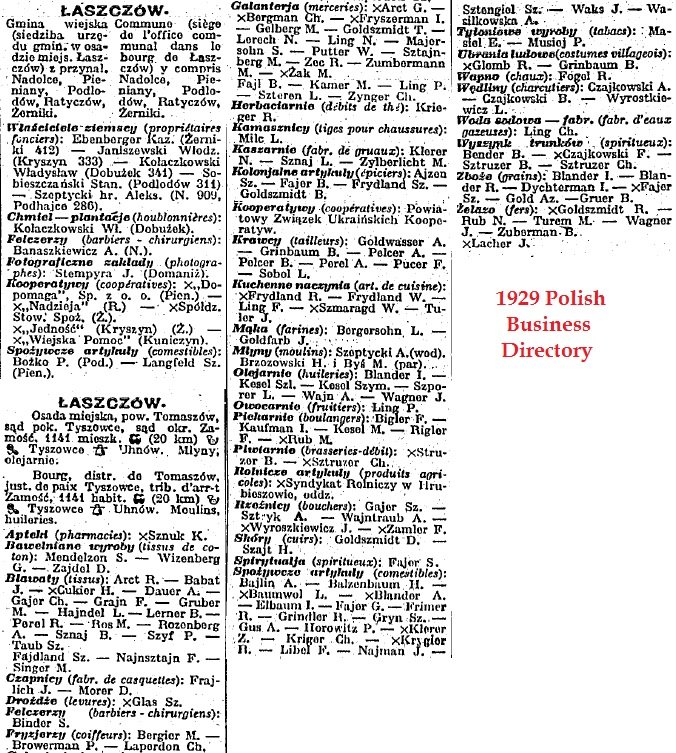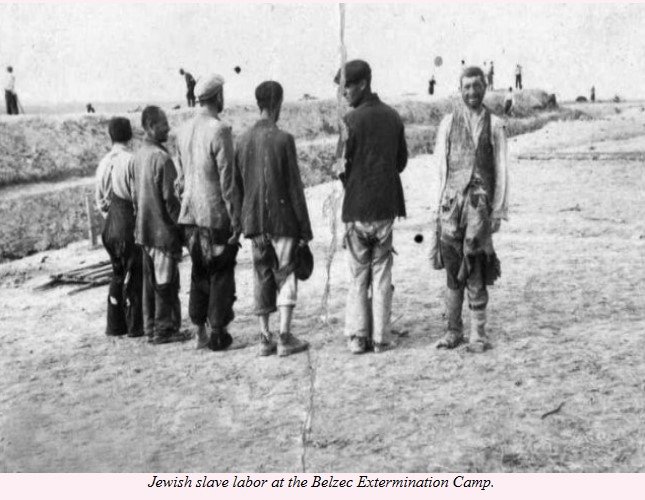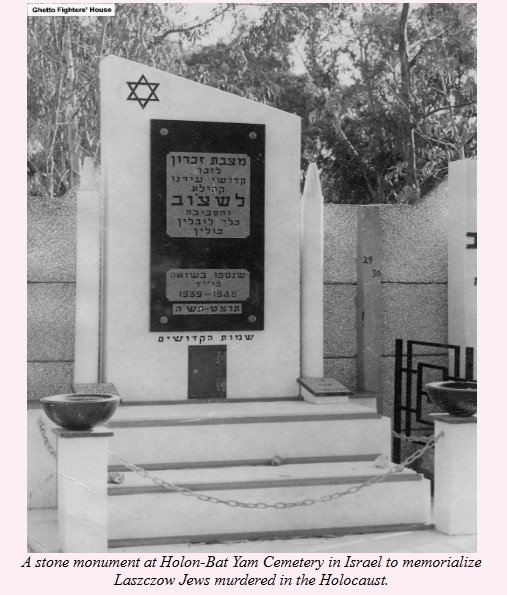Remember Jewish Łaszczów
Pronunciation: Lash-tchev
THE HISTORY OF JEWISH LASZCZOW
Laszczow is a community in southeast Poland. Combined, the administrative district and town have a current population of 9,000 residents. The administrative district now includes many smaller villages. Neighboring administrative districts include Jarczow and Tyszowce. The town is 25 km. (16 miles) east of Tomaszow Lubelski and 10 km. south of Tyszowce.
The population in 1630 numbered 422. By 1643, the number of Jewish houses in the village was 3 out of 70 total. At the end of the 17th century, an independent kehilla was established at Laszczow. Prayer houses for the Chassidim of Belz, Turzysk, Radzyn and Husyatin were established in town. By the mid-1700s, the number of Jews living in the village was ~600. In 1820, the population totaled 411, 347 of which (84%) were Jews. They made a living through trade (mostly in grain) and crafts. Their houses were located in the Market Square (Rynek) surroundings. By 1842, the population of the village was 1,160 people including 933 Jews (80%). In 1856, the population decreased to 1076, while the percentage of Jewish population rose to 93% (1,010 people). In 1902, the Laszczow population was 2,600 people, including 2,366 Jews (91%). Before the breakout of the war, the Jewish population constituted 99% of the inhabitants of the village of Laszczow, probably around 2,500 persons. Jarczow, a nearby village, had around 400 Jews in 1939.
World War I was rough on the community after it fell under the control of Russia. On Sept. 5th, 1920, three Russian soldiers arrested Rabbi Glass. He was finally released after a hefty ransom was paid. Between September 10th and 13th of 1920, the Cossacks killed a Jewish woman, raped 100 others, and injured 60 additional Jews in town. They also robbed the residents of money and jewels. After this point some of the residents left the town. Others stayed, and lived in virtual poverty. The residents were engaged in small trading, peddling and crafts. Community-based institutions operating in Laszczow included: Provident Funds, Bikur Cholim, and Linat Zedek. This period also saw the establishment of a Cooperative Bank. During the economic crisis of 1928-1931, when incomes were reduced, many Jews were saved from hunger by these institutions. The community was very Orthodox in character, and in the 1920s and 1930s the influence of the Zionist movement made itself increasingly heard.
Prior to the war, the village was remembered by a former resident as one long street made of stones, unpaved, with one a water pump serving the whole town. There was no electricity in the community. The officials in Laszczow in 1930 included: Shmuel Glas, rabbi; two shochets, Lejba Lerner and Szaja Herszberg; two other shochets had recently passed, Chaim Sznajder/Icek Wajnberg. The Laszczow Jewish committee members were: N. Lerech, J. Dychterman, Sz. Fajer, M. Zylberlicht, and Sz. Wertman.
LASZCZOW DURING THE HOLOCAUST
The Nazis occupied Laszczow in the end of September of 1939. Acts of violence and looting were routine after this point. Many of the local Polish inhabitants collaborated with the Nazis. On the third day of the occupation, the Nazis assembled all the Jewish males in the market square, and after robbing them of their few possessions they were sent to Grabowiec, and from there to the slave labor camp at Zamosc. In 1940 a Judenrat of 12 members was established in Laszczow, and was at once ordered to supply slave labor and to collect money and valuables for the Nazis. All Jews aged 12 and above were forced to wear a white armband with a blue Star of David on it. Sadly, on May 17, 1942, the Nazis transported ~1,500 Jews to the Belzec Death Camp. Few of the transported people managed to escape to a nearby forest. Only two people, neither of whom were from Laszczow, survived the Belzec Extermination Camp. In the autumn 1942, the Nazis executed 28 Jews in the forest. In June of 1944, Laszczow was burnt down by the Ukrainian Insurgent Army ("UPA").
On May 22, 1942, the Germans deported the Jews of Jarczow to the extermination camp at Belzec. Jarczow (Yarchov) had around 400 Jews living there in 1939.
The below Joint Distribution Committee listing includes names of 102 Jewish heads of household in Laszczow. They include:
Lejba Szturm?
Genia Puter?
Lejba Arbus
Perec? Arbus
Salomea? Adler Fligel
Chawa Ajzen
Lejba Baumwol
Serka Bergman
Szmuelko Brener
Zlata Brener
Wolf Balsembaum
Abram Brant
Szandla Brant
Chaja Bergman
Mirla Bigler
Icko Blander
Majer Berger
Pesia Cukier
Rechla Cukier
Icko Cukier
Ruchla Cwer
Icko Dychterman
Moszko Dorszyc
Fajwel Erlich
Dawid Engelsberg
Chawa Ejdelsztajn
Mechel Fajer
Arcia Fajer
Dina? Fajer
Szyja? Fajer
Dwojra Friszer (or Friszman)
Azryl Finger
Moszko Frymer
Mordko Fajfer
Szmuel Fridling
Lejba? Griner
Berko Grindler
Szejwa Goldsztajn
Etka Kosfiszer
Chaim Kessel
Chaja Kessel
Szloma Kessel
Majer Kessel
Szyja Kahan
Icko Klau
Cipa Kizman?
Dawid Kriger
El...? Kriger
Sz..? Kalwasser
Cipa Lerech
Naftula Lerech
Mordko Libel
Josef Lacher
Lejba Laperdon
Szyja Lew
Chawa Ling
Szy...? Lejzor Ling
Rechla Montag
Zlata Milch
Judko Muler
Dawid March
Herszko Minc
Szaja Najman
Zyndel Pargament
Szyfra Pliomp?
Sz...? Paser
Fajwel Pucer
Chaja Pelcer
Cala Rub
Chaim Rub
Abram Rub
Herc Szajnfeld
Bencia Sztryc
Lyw..? Szrajt
Moszko Szalit?
Szyja Szmyrc
Moszka Sztajnberg
Maria Szaler
Chana Szajler
Sura Szajbew
Laja Tenenbaum
Chaja Szajdler
Szy ...? Taub
Sura Wajntraub
Ita Wagner
Herc Wagner
Yankiel Waldman
Laja Teler
Szmuel Wertman
Rykla Zamler?
Szyfra Zauberman
Aron Zylberlicht
Icko Zauberman
Icko Zajdel
Yochewed Gajer
Szyja Goldsztajn
Yankiel Gelbert
Yosef Erlich
May their names be remembered.
A Jewish printing house was established in the village in the 19th century. From 1914 to 1918 a synagogue and three houses of prayer functioned. The synagogue was located on Rycerska Street. In 1770 the kehilla purchased two buildings from Count Szeptycki, a town owner. The buildings were remains of the castle destroyed in battles of the Swedish Deluge. One of the buildings (Knights' Hall) was turned into a synagogue, and the other one into the seat of the kahal and a Jewish school. A description of the synagogue is available HERE. At present, only its ruins exist, with roof and one of the walls thoroughly destroyed. An old house of prayer for women and children was situated near the synagogue. It too was destroyed by the Nazis. It was remodeled after the war and served as a fire brigade headquarters. It is now the cinema called "Strumyk". A shelter for the poor and sick operated from 1919 onward. There was also a ritual slaughterhouse.
The Jewish cemetery in the village was located on Szopena Street, west of the Market Square. It was destroyed by the Nazis and its gravestones were used to pave roads and squares. An animal clinic was built on the cemetery's property after the war. In July 1990 a monument was placed in the western part of the area where the cemetery stood. The monument is in Hebrew and in Polish. One gravestone, from the 1920s, remains. The cemetery area is fenced thanks to a Shoah survivor in Israel. Three mass tombs were established at this location. The tombs include the ashes of Jews from the town as well as nearby locations like Zimna and Nadolcach. Jakub Erlich from Haifa created this initiative.
According to a letter dated October 10, 1947 from the Joint Distribution Committee, on behalf of Holocaust survivors in Szczecin, 32 Jews from Krylow and 18 Jews from Laszczow were still living in Szczecin in poor conditions as of the date of the letter. It is unclear what happened to these 50 survivors.
Please review the site content below. Zachor - We Remember.
------------------------------------------------------------------------
[Wikipedia - Laszczow] [History] [Cemetery]
[Synagogues and Prayer Houses]
[Video: The Ruined Synagogue of Laszczow]
------------------------------------------------------------------------
Join the Laszczow group on Facebook!
Town of Laszczow:
Belzec Concentration Camp
Laszczow: Sztetl.org
Laszczow Memorial Site (Poland)
Laszczow Surname List
Holocaust Research Project: Belzec
Pinkas Hakehillot Polin: Jaczow
Pinkas Hakehillot Polin: Laszczow
Families of Laszczow:
Goldztajn family
Lederman family
Plump family
Szpiler family
Wagner family
Majdan Tatarski Ghetto Victims (Lublin) from Laszczow:
Bajla Frajlich
Notable People:
Faivel Phoebus Schiffer, poet
Rabbis of Laszczow:
Mordechai Zyskind, 1815
Yekutiel Szmul Glass, 1909-1941 (In 1920, Rabbi Glass was arrested
by the Russians and a ransom of 20,000 rubles was paid for his freedom.)
Rabbis of Jarczow:
Pesach HaLevi Sitsamer (Zitsomer)
Survivors of Jarczow:
Shlomo and Leja Blutman
Survivors of Laszczow:
Regina Rywka Binder
Yaakov Erlich
Abram Fajer
Motel Gajer
Mordko Marian Netel
Plump family
Fania Fejga (Szajt) Wertman
Righteous of Laszczow:
- The Stefaniuk family hid Rywka Dichterman in the village of Navrosc for one year.
Genealogy:
Jewish Records Indexing Poland - Laszczow
Jewish Vital Records in the Polish State Archives
Remember Your Family:
Central Judaica Database - Museum of History of Polish Jews
Grandchildren of Holocaust Survivors on Facebook
Guide to the YIVO Archives
Holocaust News/Events from Generations of the Shoah Int'l
Holocaust Survivors and Victims Database
JewishGen Family Finder
JewishGen Holocaust Database
JRI-Poland: Search for Your Family
Museum of History of Polish Jews Introduction
Yad Vashem: Search for Your Family
Yad Vashem: Submit Names of Your Family Members
Yad Vashem Requests Photos of Shoah Survivors and Families
CONTACTS
U.S.: LublinJewish@gmail.com
Return to Lublin Index








